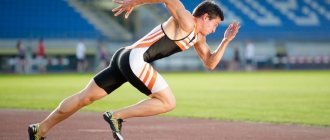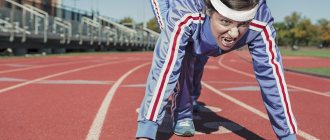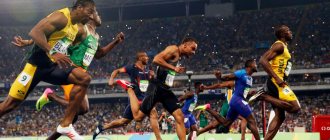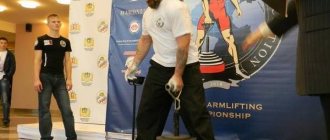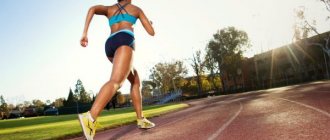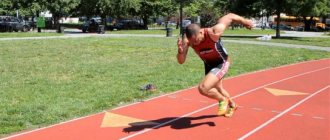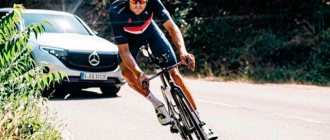Running 100m is not a time when you have to save energy or calculate your average speed. The short distance race consists of four stages:
- start
- starting run
- direct distance
- finishing
And to win the 100-meter race, you need to take into account the features of each stage. The tactics and speed of movement in these areas will be different. The rapid takeoff from the start turns into powerful acceleration, and over the next moments the runner reaches maximum speed. His main task is to save it to the finish line and be the first to touch the coveted ribbon.
Further:
What exercises will help increase your running speed?
First of all, it is necessary to note the basic principles of preparing for the 100-meter run:
- Regularity. It is advisable to train at least twice a week, then you can achieve clear progress.
- Selection of comfortable shoes and clothing. Running requires special running shoes with soft soles and a tracksuit made of breathable materials. Comfortable equipment is an important guarantee of easily covering the distance.
- Wide step. It is important to get used to running with wide strides, changing your legs as quickly as possible and helping yourself with your hands.
Exercises to increase running speed have a lot to do with developing endurance . Here are some examples of them:
- Run slowly in a straight line, gradually increasing your speed to maximum. It is recommended to run in sections of 50 meters. The optimal number of segments is 5-6.
- Repeat the same exercise, tilting your body about 5 degrees. You need to do up to 10 repetitions.
- Run 50 meter segments from a low start. Five repetitions is enough.
- Perform jumps alternating legs. You need to jump on your toes so that your heels do not touch the ground.
- Run in place, jumping up and reaching your buttocks with your heels. The back should be straight. The arms move as during normal running.
- Push off actively, jumping from one limb to another and moving forward. This exercise not only develops your running speed, but also strengthens your leg muscles.
- Take the position as at the start, placing one leg slightly forward. When buckling, you need to change your feet so that your heels do not touch the ground.
- As you exhale, strain your calves and rise onto your toes; as you inhale, return to the starting position.
- In a standing position, you need to place one foot on a stool. As you exhale, rise onto the toes of your foot on the floor, and as you inhale, return back.
- Roll from toe to heel. It is recommended to hold on to the back of the chair and control your posture.
- Jump in place, trying to push off the ground harder and keeping your back straight.
REFERENCE. The speed of the distance is largely determined by the duration of contact of the foot with the surface. The shorter this period, the faster you run. To practice this skill, you can run on your toes. Running uphill is also effective.
It is important to watch your hand movements. Their amplitude should be the same as that of the legs. Pay attention to your breathing. The body should not experience a lack of oxygen, otherwise it will be more difficult to overcome the distance.
Women's 100m race standards
- master of sports of international class - not taken into account in manual timing; on auto-timing 11.34 seconds
- MS – 11.6 seconds on manual timing, 11.84 on auto
- KMS – 12.2 seconds on manual, 12.44 seconds on auto
- 1st category – 12.8 seconds on manual, 13.04 seconds on auto
- 2nd category – 13.6 seconds on manual, 13.84 seconds on auto
- 3rd category – 14.7 seconds on manual, 14.94 seconds on auto
- 1 youth – 15.3 seconds manual, 15.54 seconds auto
- 2 youth – 16 seconds on manual, 16.24 seconds on auto
- 3 youth – 17 seconds on manual, 17.24 seconds on auto
See in more detail: Table of ranks and standards for running You may also find it useful: How to get a rank for running in theory and practice
Exercises for muscle development and strength
To improve your 100 meter running, you need to pay enough attention to honing your technique, developing muscles and pushing power in your legs . The following exercises will help with this:
- You need to pick up dumbbells and press them to your shoulders. Squat deeply and smoothly, then jump up sharply, pushing off the ground with maximum force. Both legs must push off at the same time. In order to increase the load, you can stretch your arms with dumbbells up.
- To improve your running technique, it is helpful to run with a high hip lift and shin sweep. In the first case, you need to raise your knees to chest level, in the second you need to try to touch your buttocks with your heels.
- The well-known plank exercise is useful. It loads the entire body and prepares the muscles for the stress of running. The classic version of the plank is done as follows: you need to take a lying position, bend your elbows at a right angle, place your elbows no wider than your shoulders, place your forearms parallel. The body should be stretched out like a string, with the elbows and toes acting as support. The abs and buttocks should tighten. Stand in the plank for at least 30 seconds, gradually increasing this duration.
- Perform 10 half-squat jumps.
- Do soft jumps on one leg.
- Running with hops is useful. Each step needs to be stretched both in length and height.
Familiar exercises such as lunges and cycling also help develop the strength needed for a runner.
Finish throw
During the last stage of the race, the sprinter's speed usually drops by 3-8%. But the close finish is not a reason to pause deliberately. Instead, brace yourself for the final throw. The athlete with the highest running endurance wins the competition.
The end of the course is usually indicated by a ribbon that runs along the finish line. There are two ways to finish : when the sprinter touches the ribbon with his chest or shoulder. Both methods provide approximately equal opportunities to be the first to reach the finish line. The choice depends on the athlete's preferences.
The so-called “ chest throw ” is performed as follows: at the last stage of the race, sharply lean your chest forward, throwing your arms back.
To touch the finishing tape with your shoulder , you also need to lean forward while turning your shoulder towards the tape.
With both methods, the movement technique is the same: the runner shifts the center of gravity forward, while the upper body accelerates and the lower part slows down slightly. After contact with the finishing tape, you must sharply throw your swing leg forward. This will help avoid falling. “Stepping” on the leg shifts the center of gravity of the body back, the runner’s speed drops, and he gradually switches to walking.
Sprinters who have not mastered either of these methods are advised to run the finish line at maximum speed, without thinking about throwing themselves at the ribbon.
When can I expect results?
To achieve good results, it is important to train regularly and diligently. As a rule, most athletes see clear progress after 1-2 months.
There is a popular technique that makes it possible to master a fast 100-meter run in two months. It involves the following actions during the 100-meter dash:
- 0-15 meters. You need to lower your head and swing forward a little, resting your hands on the ground. At the start, you need to push off strongly with your starting foot, directing your movement not upward, but clearly forward.
- 15-40 meters. In this area, the body assumes a vertical position. You need to look forward and breathe exclusively through your nose. To develop explosive strength, it is useful to train plyometric jumps.
- 40-100 meters. The athlete must achieve maximum acceleration. You can start braking only after the finish. An exercise such as “trailer running” is useful for training speed. It will require a sled or sled with something heavy. You need to attach them to your belt with cables and start running. The weight must be selected so that the length of the step does not shorten too much because of it.
One useful exercise for training leg strength is squats . By doing them regularly, you will achieve faster results in sprinting.
Starting run
A good start gives you the advantage of a fast starting run. The take-off run is the first third of the distance, which is covered at 90-95% of the maximum speed. The higher the runner's qualifications, the larger part of the distance is the run-up.
After the start, the body is in a forced bent state. Remember that the first steps of acceleration should be frequent, and the stride length should be optimal to maintain the selected body inclination. Don't try to stand up completely straight during the first moment of running. If you immediately straighten up and look forward, you will lose time and conditions for an effective run. Straighten your body gradually, over the first 7-10 steps of the movement.
For whom exercises are contraindicated?
Exercises to develop the strength and speed of a runner have the same list of contraindications as running itself. They are not recommended to be performed for pathologies of the heart and blood vessels, hypertension, diseases of the spine, chronic diseases at the acute stage.
ATTENTION! Persons who do not have health problems should also regulate the load and monitor their well-being during exercise. At first it is better to study under the guidance of an instructor.
Men's 100m sprint standards
- master of sports of international class - not taken into account in manual timing; on auto-timing 10.34 seconds
- MS – 10.4 seconds on manual, 10.64 on auto
- KMS – 10.7 seconds on manual, 10.94 seconds on auto
- 1st category – 11.1 seconds on manual, 11.34 seconds on auto
- 2nd category – 11.7 seconds on manual, 11.94 seconds on auto
- 3rd category – 12.4 seconds on manual, 12.64 seconds on auto
- 1 youth – 12.8 seconds manual, 13.04 seconds auto
- 2 youth – 13.4 seconds manual, 13.64 seconds auto
- 3 youth – 14 seconds on manual, 14.24 seconds on auto
Where to spend it?
The optimal place for training is a stadium with a special rubber coating . If there is none, you can run on any suitable surface. Strength exercises can be performed both indoors and outdoors.
Before each session, experts advise stretching and warming up the muscles. This will help prepare the body for stress and prevent the risk of injury. One of the useful exercises in preparation is jumping rope. The main thing in achieving results in the 100-meter run is regularity of training and a gradual increase in load. By following all the rules, you will quickly notice progress.
What is a sprint
Less than 10sec. (this is how international-class athletes run 100m) the performance lasts for the spectators and the fight for the athletes lasts. To become a participant, some only need to purchase a ticket, while others need to spend decades of grueling training.
100m is a classic sprint. Without detracting from the merits of other sprint distances, which include 60m (only in the winter season), 200m, 400m, and 110m hurdles, Sotka is the undisputed leader in the “prestige” category.
The sprint relay races – 4x100m and 4x400m – are always interesting and emotional.
Long distances
Long distances involve running from 3 km to a marathon distance of 42 km 195 m or more.
What parameters are important to train?
Such a long route requires a lot of endurance. Therefore, it is important here to increase the level of PANO - this will allow you to run longer in the aerobic pulse zone, maintaining a high pace. The IPC plays a secondary role here.
It is very important to develop abdominal breathing to provide the body with sufficient oxygen.
You can reduce your heart rate by increasing the stroke volume of the heart - this is the result of long-term training at a slow pace.
Types of training
Regular long-term cross-country training will help you learn to run long distances very quickly.
More than 80% of exercises should take place in 2-3 pulse zones. It’s not for nothing that pulse zone 3 (75-85% MHR, approximately 135-155 beats/min) is called marathon. It allows you to develop the body’s aerobic abilities, increase endurance and increase speed.
Alternating distances perfectly improves cardio abilities. You can start with a distance of 3-5 km, then move to 10 km, then return to 7.5 km and so on.
It is important to continually increase your weekly mileage. The gain should be at least 40 km per week.
Another tip for those who want to run long distances quickly: run as slowly as possible. It is slow running that trains the body, it will help hone your technique and make progress.
Features of training
The result of increasing running speed will not last long if the following are completed:
- There is a specific goal (overcoming a distance in a certain time).
- Constant courses with full dedication.
- There is a training program.
Leg muscles are important for running speed. Therefore, you should include leg strength exercises in your course.
The second point is jumping, the ability to push and accelerate when jumping. It is necessary to perform not only static, but also dynamic exercises.
To feel the speed, you must accelerate, for example, 60 - 150 m to the finish line. Many coaches advise not to forget to include speed, jumping and strength exercises in your training, as well as to practice your running technique by performing SBU.
The most common mistakes
How to learn to run fast without making the most common mistakes? Aware means armed!
We have collected together the most common mistakes:
- No warm-up or cool-down. The muscles do not warm up, the joints are injured, from the first minutes of training the heart rate jumps, shortness of breath occurs;
- Lack of a full recovery period. When preparing for competitions, be sure to include rest, light training, and massage in your schedule. With a high density of high-intensity classes, there is a serious risk of overtraining;
- The arms swing too much - the body begins to rotate about its axis, disrupting coordination;
- The back and neck do not form an even line, the lower back muscles are overloaded;
- A beginner can try to accelerate by jumping, pushing hard off the ground, low cadence + moving his legs forward. This is completely wrong! High cadence, landing near the center of gravity, correct load on the foot muscles + calf muscles - will help you reach the finish line in a short time;
- Lack of strength training in preparation for sprinting does not allow the development of “fast” muscle fibers.
Hand movement technique
Some beginners naively believe that running fast is the result of training the legs exclusively, but the arms are no less important in running .
For both sprinters and intermediate athletes, the technique of arm movement during running plays an important role. For the former it is important throughout the entire distance, for the latter it is more important at the finish line. Proper movement of the arms and shoulder girdle literally makes the legs run faster.
Correct hand technique:
- The hands are relaxed;
- Shoulders slightly raised;
- Arms bent at the elbows;
- Movements occur along the body asymmetrically to the movement of the legs (right leg in front - right hand in back, left leg in front - left leg in back).
For those entering the army under contract, military personnel, special services of the Russian Federation
To enter the army, women and men will need to pass the 100-meter test with the following results:
| Men | Women | ||
| Under 30 years old | 15.1 sec | Under 25 years old | 19.5 sec |
| Over 30 years old | 15.8 sec | Over 25 years old | 20.5 sec |
Military personnel also systematically confirm that their level of physical fitness is high.
| Navy | 15.1 sec |
| Airborne troops | 14.1 sec |
| Federal Security Service and Federal Security Service | 14.4 for an officer and 12.7 for a special forces soldier |
The 100-meter standards allow you to find out about a person’s level of physical fitness. They are known not only within the Olympics. Passing the sprint is mandatory in educational institutions (general education and higher education), as well as for employees in government agencies of the country. The amount of time allotted for jogging varies depending on age, gender, and the title for which the person is applying.
Middle distances
Middle distance running involves distances from 800 to 2000 m.
What parameters are important to train?
The main emphasis should be on speed endurance. The body must learn to quickly break down substances, remove metabolic products, and consume energy through the muscles. Such training increases VO2 max, PANO, running economy, improves the functioning of the cardiovascular system and nerve conduction, and develops the capillary network.
Types of training
How to run fast to improve mid-distance? At least 40% of training should be focused on developing speed endurance:
- Tempo running is jogging at the same speed at the anaerobic threshold level (83-87% of MOC) for about 20-30 minutes;
- Interval training: alternating cycles of fast + slow running.
You can create programs based on time/distance. For example , 800 m fast run + 600 m slow - 6-8 repetitions. Or 2 min fast + 4 min slow + 3 min fast + 3 min slow + 4 min fast + 2 min slow run. - Fartlek is an alternation of different speeds without a fixed duration (depending on how you feel);
- Uphill intervals - gentle elevations of 300-500 m (overcome 6-10 times). The muscles of the anterior thigh are actively trained.
It is important to alternate high-intensity workouts with long jogging. This allows you to develop general physical fitness, the functioning of the respiratory + cardiovascular system, strengthen joints, and increase the lactate threshold.
